check engine MITSUBISHI L200 2015 Owner's Manual (in English)
[x] Cancel search | Manufacturer: MITSUBISHI, Model Year: 2015, Model line: L200, Model: MITSUBISHI L200 2015Pages: 418, PDF Size: 25.8 MB
Page 46 of 418
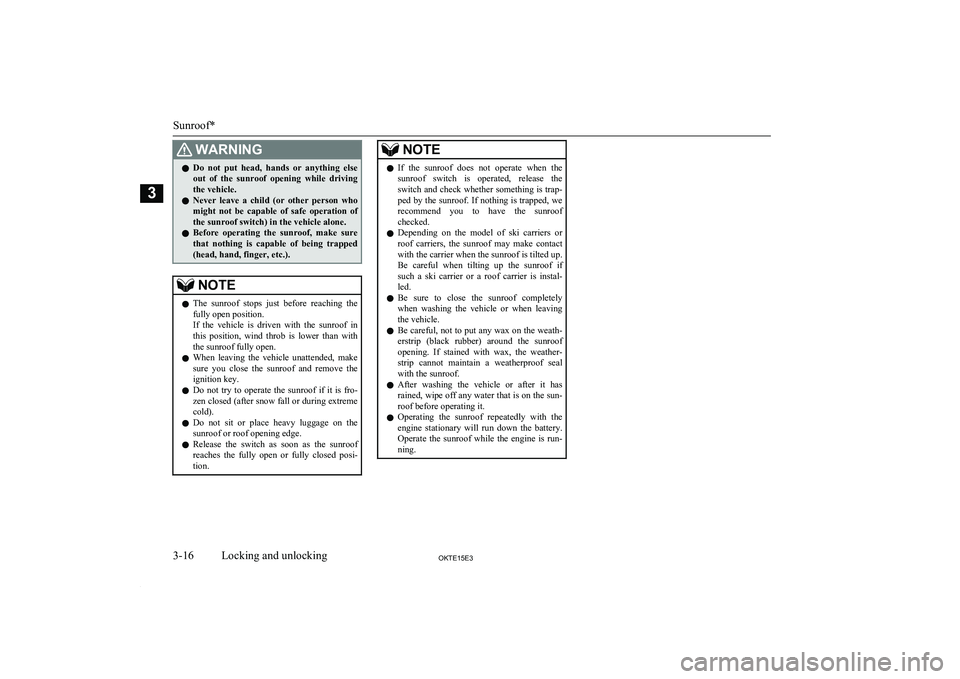
WARNINGlDo not put head, hands or anything else
out of the sunroof opening while driving
the vehicle.
l Never leave a child (or other person who
might not be capable of safe operation of
the sunroof switch) in the vehicle alone.
l Before operating the sunroof, make sure
that nothing is capable of being trapped
(head, hand, finger, etc.).NOTEl The sunroof stops just before reaching the
fully open position.
If the vehicle is driven with the sunroof in
this position, wind throb is lower than with the sunroof fully open.
l When leaving the vehicle unattended, make
sure you close the sunroof and remove the ignition key.
l Do not try to operate the sunroof if it is fro-
zen closed (after snow fall or during extreme cold).
l Do not sit or place heavy luggage on the
sunroof or roof opening edge.
l Release the switch as soon as the sunroof
reaches the fully open or fully closed posi-
tion.NOTEl If the sunroof does not operate when the
sunroof switch is operated, release the switch and check whether something is trap-
ped by the sunroof. If nothing is trapped, we recommend you to have the sunroof
checked.
l Depending on the model of ski carriers or
roof carriers, the sunroof may make contactwith the carrier when the sunroof is tilted up.Be careful when tilting up the sunroof if
such a ski carrier or a roof carrier is instal-
led.
l Be sure to close the sunroof completely
when washing the vehicle or when leaving
the vehicle.
l Be careful, not to put any wax on the weath-
erstrip (black rubber) around the sunroof opening. If stained with wax, the weather-
strip cannot maintain a weatherproof seal with the sunroof.
l After washing the vehicle or after it has
rained, wipe off any water that is on the sun-
roof before operating it.
l Operating the sunroof repeatedly with the
engine stationary will run down the battery. Operate the sunroof while the engine is run-
ning.
Sunroof*
3-16OKTE15E3Locking and unlocking3
Page 94 of 418
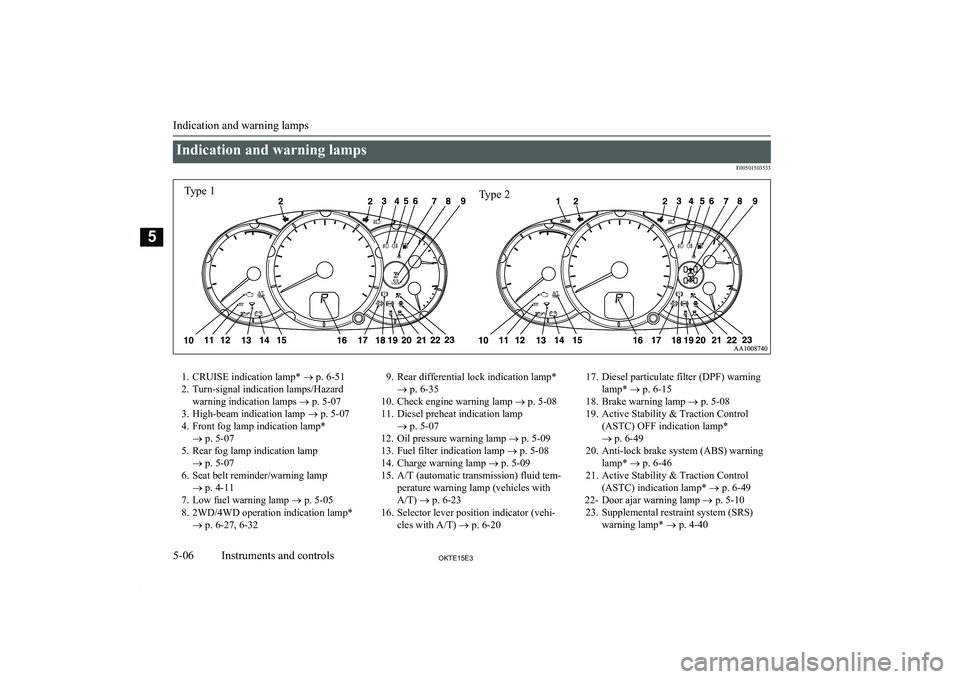
Indication and warning lampsE005015035331. CRUISE indication lamp* ® p. 6-51
2. Turn-signal indication lamps/Hazard warning indication lamps ® p. 5-07
3. High-beam indication lamp ® p. 5-07
4. Front fog lamp indication lamp* ® p. 5-07
5. Rear fog lamp indication lamp ® p. 5-07
6. Seat belt reminder/warning lamp ® p. 4-11
7. Low fuel warning lamp ® p. 5-05
8. 2WD/4WD operation indication lamp* ® p. 6-27, 6-329. Rear differential lock indication lamp*
® p. 6-35
10. Check engine warning lamp ® p. 5-08
11. Diesel preheat indication lamp ® p. 5-07
12. Oil pressure warning lamp ® p. 5-09
13. Fuel filter indication lamp ® p. 5-08
14. Charge warning lamp ® p. 5-09
15. A/T (automatic transmission) fluid tem- perature warning lamp (vehicles with
A/T) ® p. 6-23
16. Selector lever position indicator (vehi- cles with A/T) ® p. 6-2017. Diesel particulate filter (DPF) warning
lamp* ® p. 6-15
18. Brake warning lamp ® p. 5-08
19. Active Stability & Traction Control (ASTC) OFF indication lamp*
® p. 6-49
20. Anti-lock brake system (ABS) warning lamp* ® p. 6-46
21. Active Stability & Traction Control (ASTC) indication lamp* ® p. 6-49
22- Door ajar warning lamp ® p. 5-10
23. Supplemental restraint system (SRS) warning lamp* ® p. 4-40
Indication and warning lamps
5-06OKTE15E3Instruments and controls5Type 1Type 2
Page 96 of 418
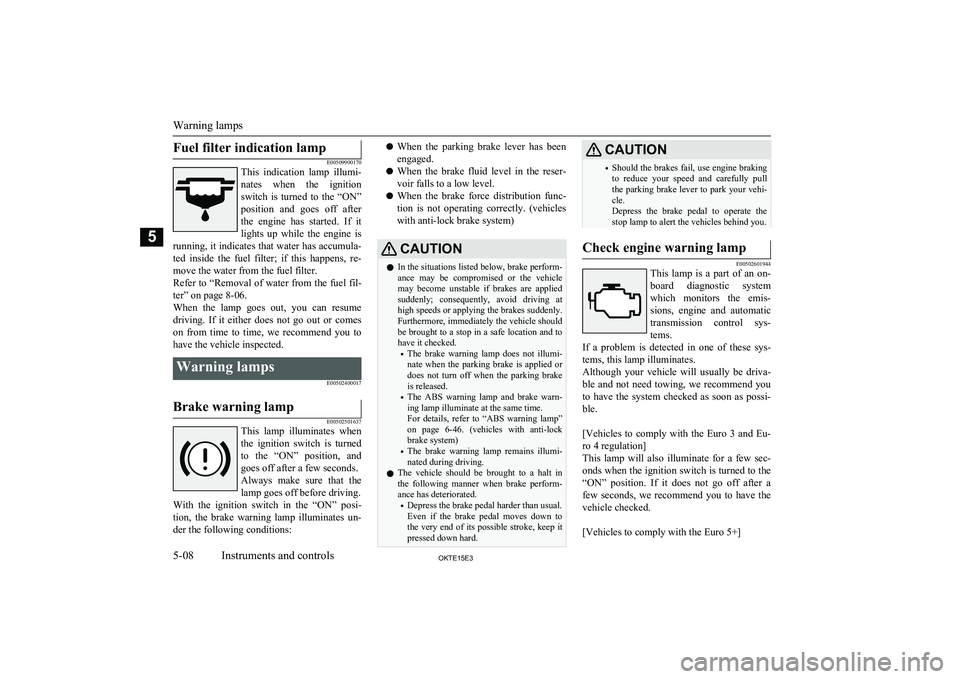
Fuel filter indication lamp
E00509900170
This indication lamp illumi-
nates when the ignition switch is turned to the “ON”
position and goes off after the engine has started. If itlights up while the engine is
running, it indicates that water has accumula- ted inside the fuel filter; if this happens, re-
move the water from the fuel filter.
Refer to “Removal of water from the fuel fil- ter” on page 8-06.When the lamp goes out, you can resume
driving. If it either does not go out or comes on from time to time, we recommend you to
have the vehicle inspected.Warning lamps
E00502400017Brake warning lamp
E00502501637
This lamp illuminates whenthe ignition switch is turnedto the “ON” position, and goes off after a few seconds.
Always make sure that the
lamp goes off before driving.
With the ignition switch in the “ON” posi-
tion, the brake warning lamp illuminates un- der the following conditions:
l When the parking brake lever has been
engaged.
l When the brake fluid level in the reser-
voir falls to a low level.
l When the brake force distribution func-
tion is not operating correctly. (vehicles
with anti-lock brake system)CAUTIONl In the situations listed below, brake perform-
ance may be compromised or the vehicle
may become unstable if brakes are applied
suddenly; consequently, avoid driving at high speeds or applying the brakes suddenly.
Furthermore, immediately the vehicle should be brought to a stop in a safe location and to have it checked.
• The brake warning lamp does not illumi-
nate when the parking brake is applied ordoes not turn off when the parking brake is released.
• The ABS warning lamp and brake warn-
ing lamp illuminate at the same time.
For details, refer to “ABS warning lamp”
on page 6-46. (vehicles with anti-lock
brake system)
• The brake warning lamp remains illumi-
nated during driving.
l The vehicle should be brought to a halt in
the following manner when brake perform-
ance has deteriorated.
• Depress the brake pedal harder than usual.
Even if the brake pedal moves down to
the very end of its possible stroke, keep it
pressed down hard.CAUTION• Should the brakes fail, use engine braking
to reduce your speed and carefully pull the parking brake lever to park your vehi-
cle.
Depress the brake pedal to operate the
stop lamp to alert the vehicles behind you.Check engine warning lamp
E00502601944
This lamp is a part of an on-
board diagnostic system
which monitors the emis-
sions, engine and automatic transmission control sys-tems.
If a problem is detected in one of these sys- tems, this lamp illuminates.
Although your vehicle will usually be driva-
ble and not need towing, we recommend you
to have the system checked as soon as possi-
ble.
[Vehicles to comply with the Euro 3 and Eu-
ro 4 regulation]
This lamp will also illuminate for a few sec- onds when the ignition switch is turned to the “ON” position. If it does not go off after a
few seconds, we recommend you to have the vehicle checked.
[Vehicles to comply with the Euro 5+]
Warning lamps
5-08OKTE15E3Instruments and controls5
Page 97 of 418
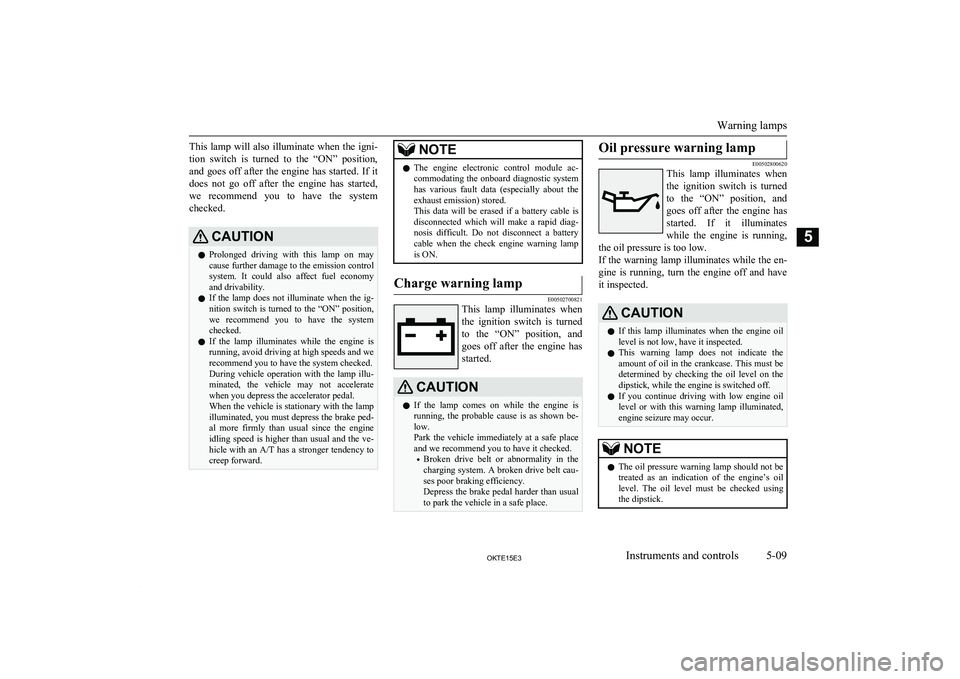
This lamp will also illuminate when the igni-
tion switch is turned to the “ON” position, and goes off after the engine has started. If it
does not go off after the engine has started,
we recommend you to have the system checked.CAUTIONl Prolonged driving with this lamp on may
cause further damage to the emission control
system. It could also affect fuel economy and drivability.
l If the lamp does not illuminate when the ig-
nition switch is turned to the “ON” position, we recommend you to have the system
checked.
l If the lamp illuminates while the engine is
running, avoid driving at high speeds and we recommend you to have the system checked.
During vehicle operation with the lamp illu-
minated, the vehicle may not accelerate
when you depress the accelerator pedal.
When the vehicle is stationary with the lamp illuminated, you must depress the brake ped- al more firmly than usual since the engine
idling speed is higher than usual and the ve- hicle with an A/T has a stronger tendency to
creep forward.NOTEl The engine electronic control module ac-
commodating the onboard diagnostic system has various fault data (especially about the
exhaust emission) stored.
This data will be erased if a battery cable is
disconnected which will make a rapid diag- nosis difficult. Do not disconnect a batterycable when the check engine warning lamp
is ON.Charge warning lamp
E00502700821
This lamp illuminates when
the ignition switch is turnedto the “ON” position, and goes off after the engine has
started.
CAUTIONl If the lamp comes on while the engine is
running, the probable cause is as shown be-low.
Park the vehicle immediately at a safe place
and we recommend you to have it checked.
• Broken drive belt or abnormality in the
charging system. A broken drive belt cau-
ses poor braking efficiency.
Depress the brake pedal harder than usual
to park the vehicle in a safe place.Oil pressure warning lamp
E00502800620
This lamp illuminates when
the ignition switch is turnedto the “ON” position, and goes off after the engine has
started. If it illuminates
while the engine is running,
the oil pressure is too low.
If the warning lamp illuminates while the en- gine is running, turn the engine off and have
it inspected.
CAUTIONl If this lamp illuminates when the engine oil
level is not low, have it inspected.
l This warning lamp does not indicate the
amount of oil in the crankcase. This must be determined by checking the oil level on the
dipstick, while the engine is switched off.
l If you continue driving with low engine oil
level or with this warning lamp illuminated,
engine seizure may occur.NOTEl The oil pressure warning lamp should not be
treated as an indication of the engine’s oil
level. The oil level must be checked using
the dipstick.
Warning lamps
5-09OKTE15E3Instruments and controls5
Page 120 of 418

2.Press the “SET” function button. The
display will flash twice and the barome- ter indication will return to the factory
settings.NOTEl Although the barometer value is changed to
the factory setting, a barometer unit you have selected is unchanged.
l You can return to the previous display by
pressing the “BACK” function button.3. After setting the barometer default, press
the “INFO” button to return to the infor-
mation display.Care of the monitor
E00519700012
If the monitor becomes covered in finger-
prints or otherwise dirty, clean it with a soft and dry cloth.
NOTEl Don’t use a wet cloth or abrasive cleaner as
this may cause damage.Combination headlamps
and dipper switch E00506003533
HeadlampsNOTEl Do not leave the headlamps and other lamps
on for a long time while the engine is sta-tionary (not running). A run-down batterycould result.
l When it rains or when the vehicle has been
washed, the inside of the lens sometimes be-
comes foggy. This is the same phenomenon as when window glass mists up on a humid
day, and does not indicate a functional prob- lem. When the lamp is switched on, the heat
will remove the fog. However, if water gath-
ers inside the lamp, we recommend you to have it checked.
Combination headlamps and dipper switch
5-32OKTE15E3Instruments and controls5
Page 134 of 418
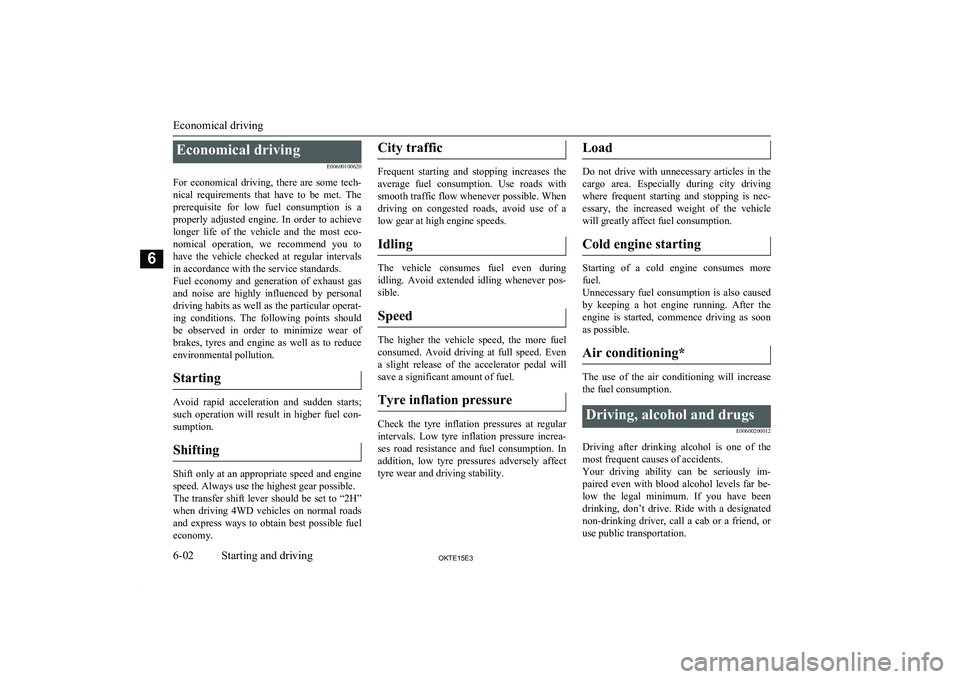
Economical drivingE00600100620
For economical driving, there are some tech- nical requirements that have to be met. Theprerequisite for low fuel consumption is a
properly adjusted engine. In order to achieve longer life of the vehicle and the most eco- nomical operation, we recommend you tohave the vehicle checked at regular intervals in accordance with the service standards.
Fuel economy and generation of exhaust gas
and noise are highly influenced by personal
driving habits as well as the particular operat- ing conditions. The following points shouldbe observed in order to minimize wear of
brakes, tyres and engine as well as to reduce
environmental pollution.
Starting
Avoid rapid acceleration and sudden starts;
such operation will result in higher fuel con-
sumption.
Shifting
Shift only at an appropriate speed and engine speed. Always use the highest gear possible.
The transfer shift lever should be set to “2H” when driving 4WD vehicles on normal roads
and express ways to obtain best possible fuel economy.
City traffic
Frequent starting and stopping increases the
average fuel consumption. Use roads with smooth traffic flow whenever possible. When driving on congested roads, avoid use of a
low gear at high engine speeds.
Idling
The vehicle consumes fuel even during
idling. Avoid extended idling whenever pos- sible.
Speed
The higher the vehicle speed, the more fuel
consumed. Avoid driving at full speed. Even a slight release of the accelerator pedal will
save a significant amount of fuel.
Tyre inflation pressure
Check the tyre inflation pressures at regularintervals. Low tyre inflation pressure increa-ses road resistance and fuel consumption. In addition, low tyre pressures adversely affect tyre wear and driving stability.
Load
Do not drive with unnecessary articles in the
cargo area. Especially during city driving where frequent starting and stopping is nec-
essary, the increased weight of the vehicle will greatly affect fuel consumption.
Cold engine starting
Starting of a cold engine consumes morefuel.
Unnecessary fuel consumption is also caused by keeping a hot engine running. After the
engine is started, commence driving as soon
as possible.
Air conditioning*
The use of the air conditioning will increase the fuel consumption.
Driving, alcohol and drugs
E00600200012
Driving after drinking alcohol is one of the
most frequent causes of accidents.
Your driving ability can be seriously im- paired even with blood alcohol levels far be-
low the legal minimum. If you have been drinking, don’t drive. Ride with a designated non-drinking driver, call a cab or a friend, or
use public transportation.
Economical driving
6-02OKTE15E3Starting and driving6
Page 152 of 418
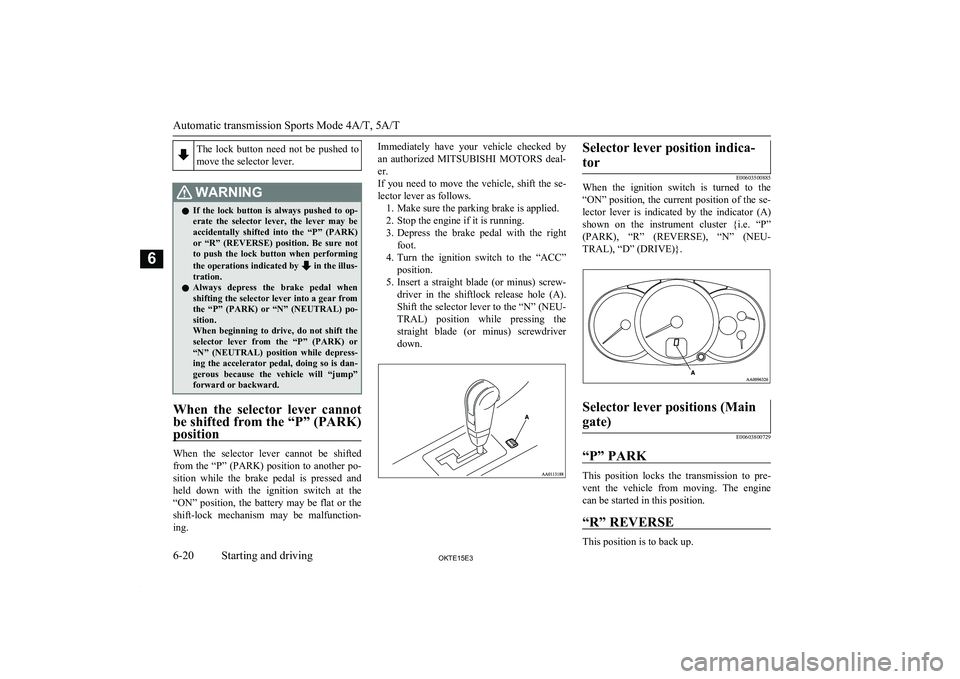
The lock button need not be pushed to
move the selector lever.WARNINGl If the lock button is always pushed to op-
erate the selector lever, the lever may beaccidentally shifted into the “P” (PARK)
or “R” (REVERSE) position. Be sure not to push the lock button when performing
the operations indicated by
in the illus-
tration.
l Always depress the brake pedal when
shifting the selector lever into a gear from the “P” (PARK) or “N” (NEUTRAL) po-sition.
When beginning to drive, do not shift the
selector lever from the “P” (PARK) or
“N” (NEUTRAL) position while depress-
ing the accelerator pedal, doing so is dan- gerous because the vehicle will “jump”
forward or backward.
When the selector lever cannot
be shifted from the “P” (PARK)
position
When the selector lever cannot be shifted from the “P” (PARK) position to another po-
sition while the brake pedal is pressed and
held down with the ignition switch at the
“ON” position, the battery may be flat or the shift-lock mechanism may be malfunction- ing.
Immediately have your vehicle checked by
an authorized MITSUBISHI MOTORS deal-
er.
If you need to move the vehicle, shift the se- lector lever as follows. 1. Make sure the parking brake is applied.
2. Stop the engine if it is running.
3. Depress the brake pedal with the right
foot.
4. Turn the ignition switch to the “ACC”
position.
5. Insert a straight blade (or minus) screw-
driver in the shiftlock release hole (A).
Shift the selector lever to the “N” (NEU-
TRAL) position while pressing the straight blade (or minus) screwdriver down.Selector lever position indica-
tor
E00603500885
When the ignition switch is turned to the
“ON” position, the current position of the se- lector lever is indicated by the indicator (A)
shown on the instrument cluster {i.e. “P” (PARK), “R” (REVERSE), “N” (NEU-
TRAL), “D” (DRIVE)}.
Selector lever positions (Main
gate)
E00603800729
“P” PARK
This position locks the transmission to pre- vent the vehicle from moving. The engine
can be started in this position.
“R” REVERSE
This position is to back up.
Automatic transmission Sports Mode 4A/T, 5A/T
6-20OKTE15E3Starting and driving6
Page 156 of 418
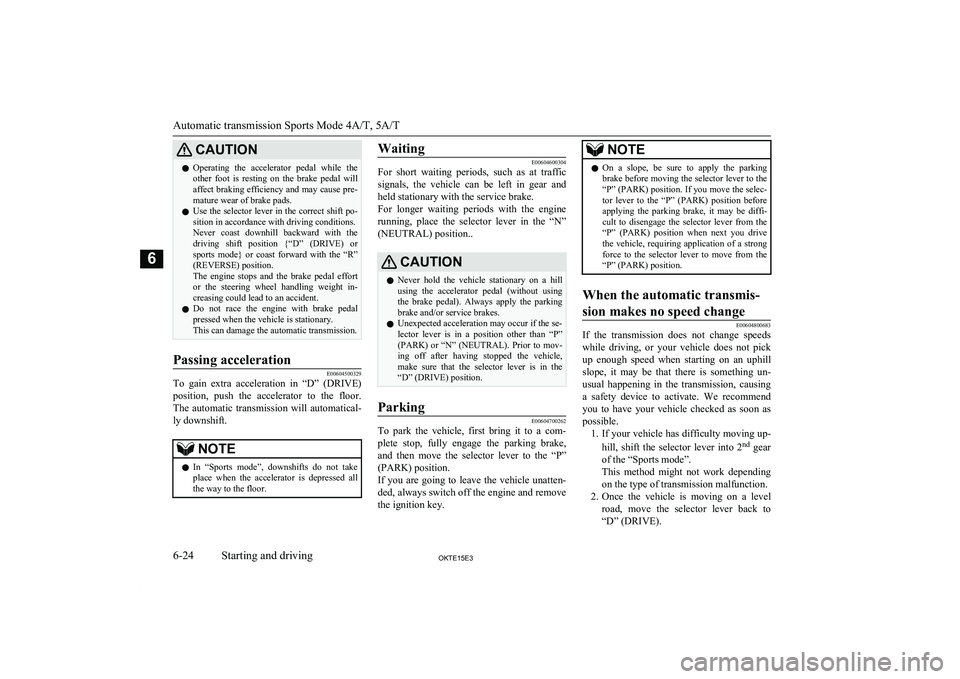
CAUTIONlOperating the accelerator pedal while the
other foot is resting on the brake pedal will affect braking efficiency and may cause pre-
mature wear of brake pads.
l Use the selector lever in the correct shift po-
sition in accordance with driving conditions.Never coast downhill backward with the
driving shift position {“D” (DRIVE) or
sports mode} or coast forward with the “R” (REVERSE) position.
The engine stops and the brake pedal effort or the steering wheel handling weight in-creasing could lead to an accident.
l Do not race the engine with brake pedal
pressed when the vehicle is stationary.
This can damage the automatic transmission.Passing acceleration
E00604500329
To gain extra acceleration in “D” (DRIVE)
position, push the accelerator to the floor.The automatic transmission will automatical- ly downshift.
NOTEl In “Sports mode”, downshifts do not take
place when the accelerator is depressed all
the way to the floor.Waiting
E00604600304
For short waiting periods, such as at traffic
signals, the vehicle can be left in gear and held stationary with the service brake.
For longer waiting periods with the engine
running, place the selector lever in the “N” (NEUTRAL) position..CAUTIONl Never hold the vehicle stationary on a hill
using the accelerator pedal (without using the brake pedal). Always apply the parking
brake and/or service brakes.
l Unexpected acceleration may occur if the se-
lector lever is in a position other than “P”
(PARK) or “N” (NEUTRAL). Prior to mov-
ing off after having stopped the vehicle, make sure that the selector lever is in the
“D” (DRIVE) position.Parking
E00604700262
To park the vehicle, first bring it to a com-
plete stop, fully engage the parking brake,and then move the selector lever to the “P”
(PARK) position.
If you are going to leave the vehicle unatten-
ded, always switch off the engine and remove the ignition key.
NOTEl On a slope, be sure to apply the parking
brake before moving the selector lever to the
“P” (PARK) position. If you move the selec- tor lever to the “P” (PARK) position before applying the parking brake, it may be diffi-
cult to disengage the selector lever from the
“P” (PARK) position when next you drive the vehicle, requiring application of a strong
force to the selector lever to move from the
“P” (PARK) position.When the automatic transmis-
sion makes no speed change
E00604800683
If the transmission does not change speeds
while driving, or your vehicle does not pick up enough speed when starting on an uphillslope, it may be that there is something un-
usual happening in the transmission, causing a safety device to activate. We recommendyou to have your vehicle checked as soon as
possible. 1. If your vehicle has difficulty moving up-
hill, shift the selector lever into 2 nd
gear
of the “Sports mode”.
This method might not work depending
on the type of transmission malfunction.
2. Once the vehicle is moving on a level
road, move the selector lever back to“D” (DRIVE).
Automatic transmission Sports Mode 4A/T, 5A/T
6-24OKTE15E3Starting and driving6
Page 170 of 418
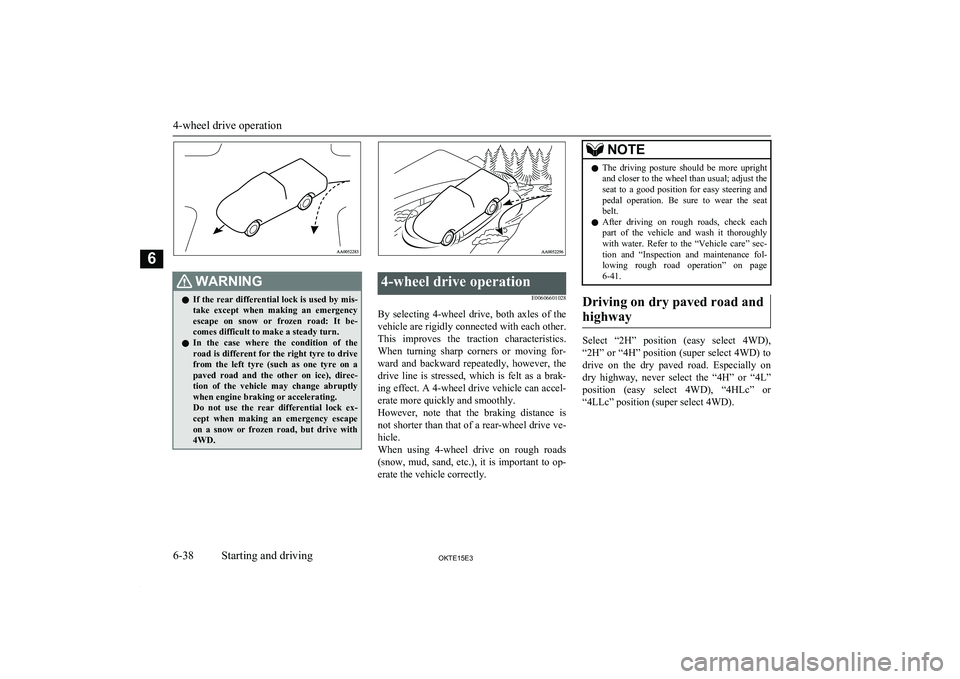
WARNINGlIf the rear differential lock is used by mis-
take except when making an emergencyescape on snow or frozen road: It be-
comes difficult to make a steady turn.
l In the case where the condition of the
road is different for the right tyre to drive from the left tyre (such as one tyre on a
paved road and the other on ice), direc- tion of the vehicle may change abruptly
when engine braking or accelerating.
Do not use the rear differential lock ex- cept when making an emergency escape
on a snow or frozen road, but drive with 4WD.4-wheel drive operation
E00606601028
By selecting 4-wheel drive, both axles of the
vehicle are rigidly connected with each other. This improves the traction characteristics. When turning sharp corners or moving for-
ward and backward repeatedly, however, the drive line is stressed, which is felt as a brak-
ing effect. A 4-wheel drive vehicle can accel-
erate more quickly and smoothly.
However, note that the braking distance is not shorter than that of a rear-wheel drive ve-hicle.
When using 4-wheel drive on rough roads
(snow, mud, sand, etc.), it is important to op- erate the vehicle correctly.
NOTEl The driving posture should be more upright
and closer to the wheel than usual; adjust the
seat to a good position for easy steering and pedal operation. Be sure to wear the seatbelt.
l After driving on rough roads, check each
part of the vehicle and wash it thoroughlywith water. Refer to the “Vehicle care” sec-
tion and “Inspection and maintenance fol-
lowing rough road operation” on page 6-41.
Driving on dry paved road and
highway
Select “2H” position (easy select 4WD),
“2H” or “4H” position (super select 4WD) to drive on the dry paved road. Especially on dry highway, never select the “4H” or “4L”
position (easy select 4WD), “4HLc” or “4LLc” position (super select 4WD).
4-wheel drive operation
6-38OKTE15E3Starting and driving6
Page 172 of 418
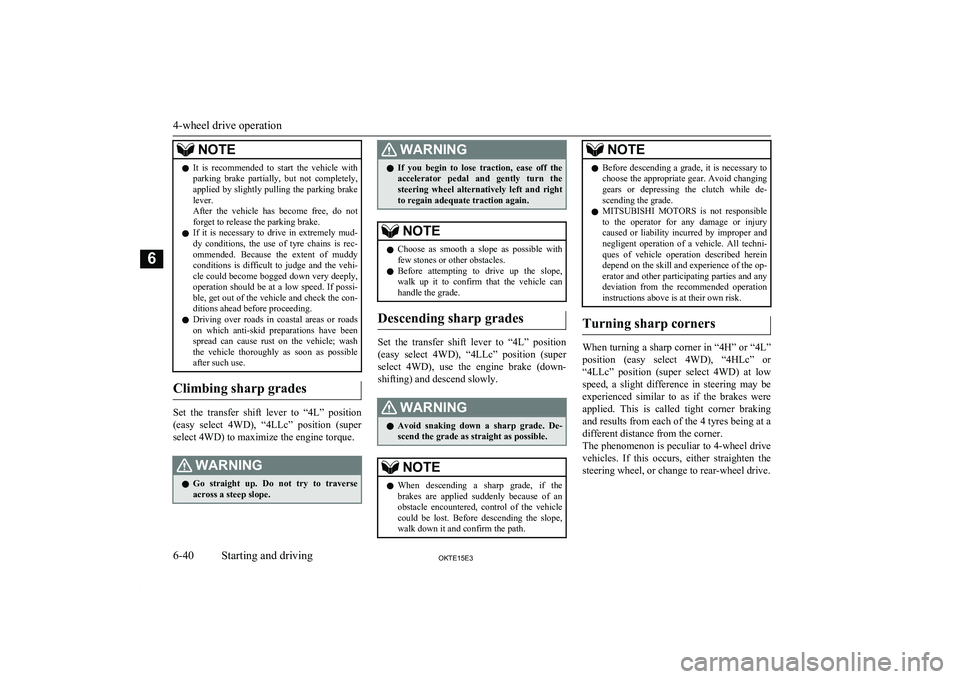
NOTElIt is recommended to start the vehicle with
parking brake partially, but not completely,applied by slightly pulling the parking brake
lever.
After the vehicle has become free, do not forget to release the parking brake.
l If it is necessary to drive in extremely mud-
dy conditions, the use of tyre chains is rec-
ommended. Because the extent of muddy conditions is difficult to judge and the vehi- cle could become bogged down very deeply,
operation should be at a low speed. If possi-
ble, get out of the vehicle and check the con- ditions ahead before proceeding.
l Driving over roads in coastal areas or roads
on which anti-skid preparations have been spread can cause rust on the vehicle; wash
the vehicle thoroughly as soon as possible
after such use.
Climbing sharp grades
Set the transfer shift lever to “4L” position
(easy select 4WD), “4LLc” position (super
select 4WD) to maximize the engine torque.
WARNINGl Go straight up. Do not try to traverse
across a steep slope.WARNINGl If you begin to lose traction, ease off the
accelerator pedal and gently turn the
steering wheel alternatively left and right to regain adequate traction again.NOTEl Choose as smooth a slope as possible with
few stones or other obstacles.
l Before attempting to drive up the slope,
walk up it to confirm that the vehicle canhandle the grade.
Descending sharp grades
Set the transfer shift lever to “4L” position
(easy select 4WD), “4LLc” position (super
select 4WD), use the engine brake (down- shifting) and descend slowly.
WARNINGl Avoid snaking down a sharp grade. De-
scend the grade as straight as possible.NOTEl When descending a sharp grade, if the
brakes are applied suddenly because of an
obstacle encountered, control of the vehicle
could be lost. Before descending the slope,
walk down it and confirm the path.NOTEl Before descending a grade, it is necessary to
choose the appropriate gear. Avoid changing
gears or depressing the clutch while de-
scending the grade.
l MITSUBISHI
MOTORS is not responsible
to the operator for any damage or injury caused or liability incurred by improper and
negligent operation of a vehicle. All techni- ques of vehicle operation described herein depend on the skill and experience of the op- erator and other participating parties and any
deviation from the recommended operation
instructions above is at their own risk.
Turning sharp corners
When turning a sharp corner in “4H” or “4L”
position (easy select 4WD), “4HLc” or “4LLc” position (super select 4WD) at low speed, a slight difference in steering may be
experienced similar to as if the brakes were applied. This is called tight corner braking and results from each of the 4 tyres being at a
different distance from the corner.
The phenomenon is peculiar to 4-wheel drive vehicles. If this occurs, either straighten the steering wheel, or change to rear-wheel drive.
4-wheel drive operation
6-40OKTE15E3Starting and driving6